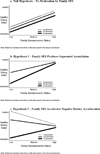Is socioeconomic incorporation associated with a healthier diet? Dietary patterns among Mexican-origin children in the United States
- PMID: 26523786
- PMCID: PMC4689621
- DOI: 10.1016/j.socscimed.2015.10.028
Is socioeconomic incorporation associated with a healthier diet? Dietary patterns among Mexican-origin children in the United States
Abstract
With each successive generation in the United States, Mexican-origin families lose their initial dietary advantages. Focusing on children's diets, we ask whether greater socioeconomic status (SES) can help buffer Mexican-origin children in immigrant families from negative dietary acculturation or whether it exacerbates these dietary risks. Pooling data from the 1999 to 2009 waves of the continuous National Health and Nutrition Examination Survey, we test whether the association between generational status and Mexican-origin children's nutrition varies by the family's SES. When predicting children's overall dietary quality using the Healthy Eating Index (2010) and predicting unhealthy dietary patterns, we find stronger evidence of segmented assimilation, whereby greater family average SES is associated with better diets across generations of Mexican-origin children. High-status Mexican-origin parents appear able to buffer their children against generational dietary declines documented in the acculturation literature.
Keywords: Acculturation; Children; Immigration; Mexican-American; Nutrition; Socioeconomic status; United States.
Copyright © 2015 Elsevier Ltd. All rights reserved.
Figures
Similar articles
-
Generational status, neighborhood context, and mother-child resemblance in dietary quality in Mexican-origin families.Soc Sci Med. 2016 Feb;150:212-20. doi: 10.1016/j.socscimed.2015.12.023. Epub 2015 Dec 21. Soc Sci Med. 2016. PMID: 26773704 Free PMC article.
-
It is Hard to Swim Upstream: Dietary Acculturation Among Mexican-Origin Children.Popul Res Policy Rev. 2016 Apr 1;35(2):177-196. doi: 10.1007/s11113-015-9381-x. Epub 2015 Dec 26. Popul Res Policy Rev. 2016. PMID: 27152059 Free PMC article.
-
Food acculturation drives dietary differences among Mexicans, Mexican Americans, and Non-Hispanic Whites.J Nutr. 2011 Oct;141(10):1898-906. doi: 10.3945/jn.111.141473. Epub 2011 Aug 31. J Nutr. 2011. PMID: 21880951 Free PMC article.
-
[Simple obesity in children. A study on the role of nutritional factors].Med Wieku Rozwoj. 2006 Jan-Mar;10(1):3-191. Med Wieku Rozwoj. 2006. PMID: 16733288 Review. Polish.
-
Positive pregnancy outcomes in Mexican immigrants: what can we learn?J Obstet Gynecol Neonatal Nurs. 2004 Nov-Dec;33(6):783-90. doi: 10.1177/0884217504270595. J Obstet Gynecol Neonatal Nurs. 2004. PMID: 15561667 Review.
Cited by
-
The Influence of Parental Education on Dietary Intake in Latino Youth.J Immigr Minor Health. 2018 Feb;20(1):250-254. doi: 10.1007/s10903-017-0563-y. J Immigr Minor Health. 2018. PMID: 28271345 Free PMC article.
-
Questioning the Dietary Acculturation Paradox: A Mixed-Methods Study of the Relationship between Food and Ethnic Identity in a Group of Mexican-American Women.J Acad Nutr Diet. 2018 Mar;118(3):431-439. doi: 10.1016/j.jand.2017.10.008. Epub 2017 Dec 28. J Acad Nutr Diet. 2018. PMID: 29289549 Free PMC article.
-
Effects of Latino children on their mothers' dietary intake and dietary behaviors: The role of children's acculturation and the mother-child acculturation gap.Soc Sci Med. 2017 Oct;191:125-133. doi: 10.1016/j.socscimed.2017.09.004. Epub 2017 Sep 5. Soc Sci Med. 2017. PMID: 28917621 Free PMC article.
-
Exploring Latinidad, Migration Processes, and Immigrant Experiences: Experiences Influencing Latino Health.Kans J Med. 2019 Nov 25;12(4):125-131. eCollection 2019 Nov. Kans J Med. 2019. PMID: 31803354 Free PMC article.
-
Beyond fatalism: Information overload as a mechanism to understand health disparities.Soc Sci Med. 2018 Dec;219:11-18. doi: 10.1016/j.socscimed.2018.10.006. Epub 2018 Oct 13. Soc Sci Med. 2018. PMID: 30342382 Free PMC article.
References
-
- Acevedo-Garcia D, Bates LM. Latino health paradoxes: empirical evidence, explanations, future research, and implications. In: Rodríguez H, Sáenz R, Menjívar C, editors. Latinas/os in the United States: Changing the face of America. New York: Springer; 2008. pp. 101–113.
-
- Acevedo-Garcia D, Bates LM, Osypuk TL, McArdle N. The effect of immigrant generation and duration on self-rated health among US adults 2003–2007. Social Science & Medicine. 2010;71(6):1161–1172. - PubMed
-
- Akresh IR. Dietary assimilation and health among Hispanic immigrants to the United States. Journal of Health and Social Behavior. 2007;48(4):404–417. - PubMed
-
- Alba R, Nee V. Remaking the American mainstream: Assimilation and contemporary immigration. Cambridge: Harvard University Press; 2003.
Publication types
MeSH terms
Grants and funding
LinkOut - more resources
Full Text Sources
Other Literature Sources




